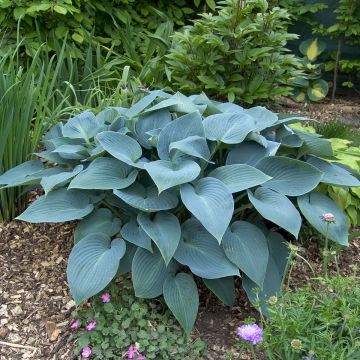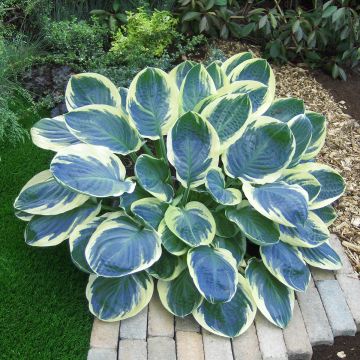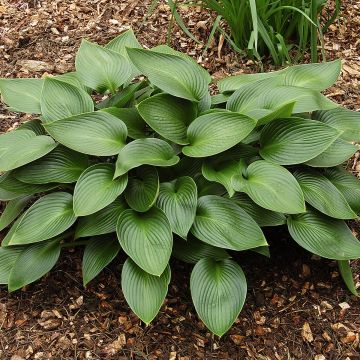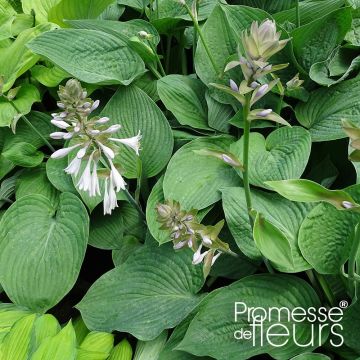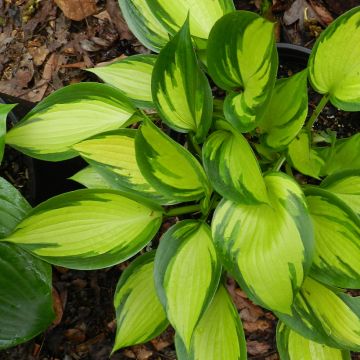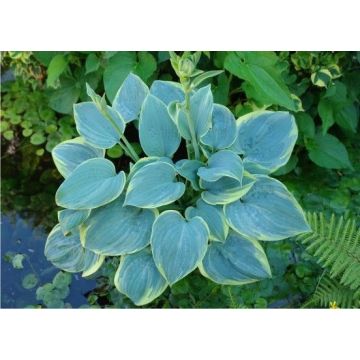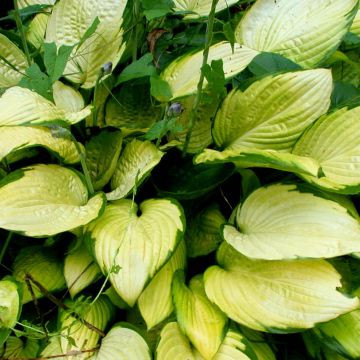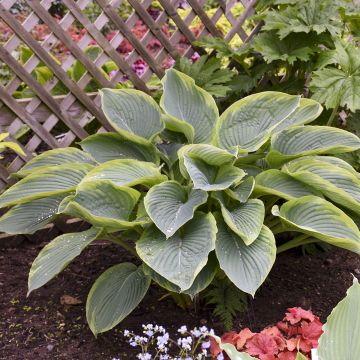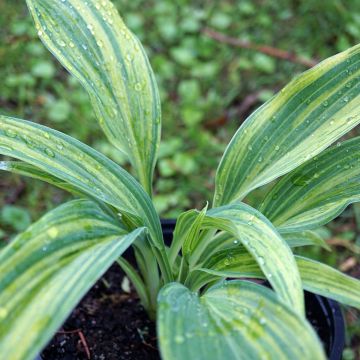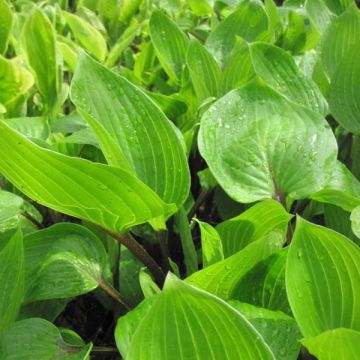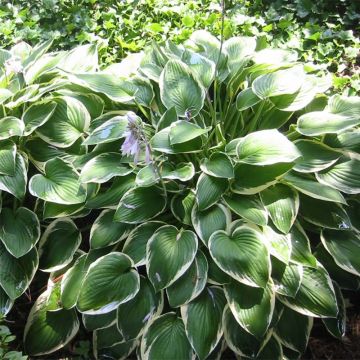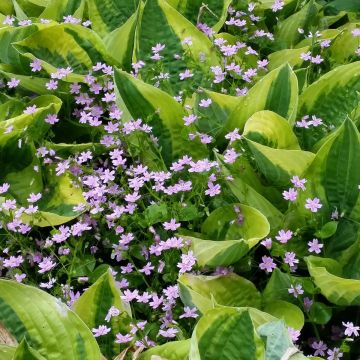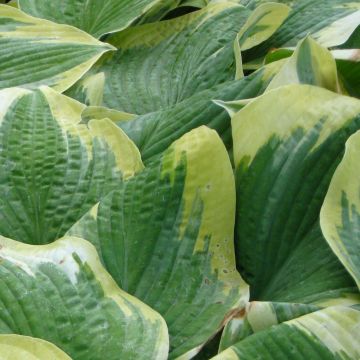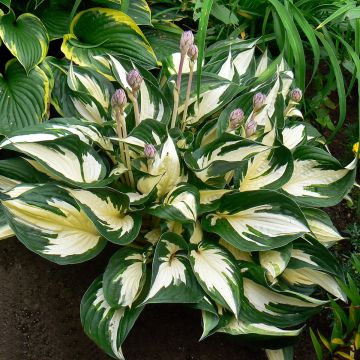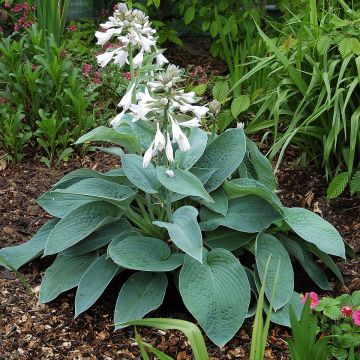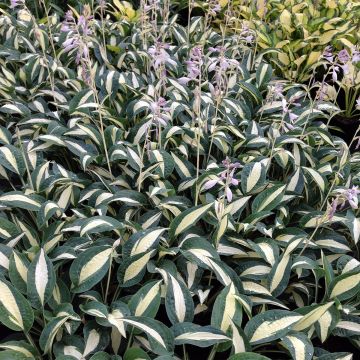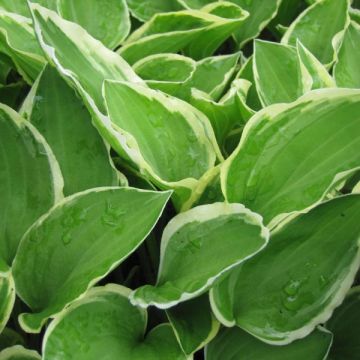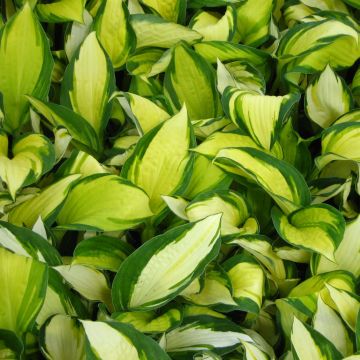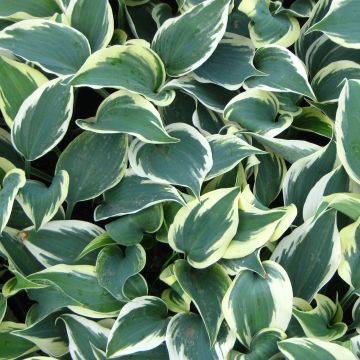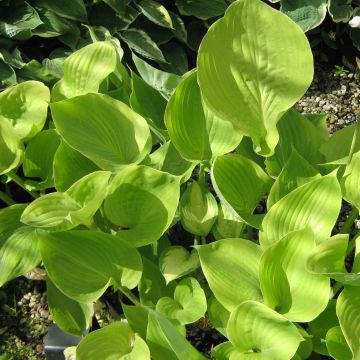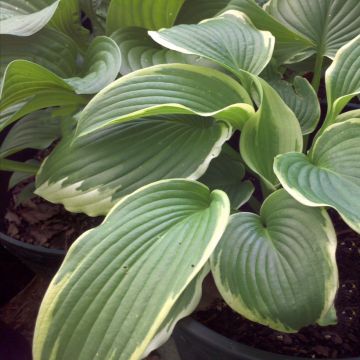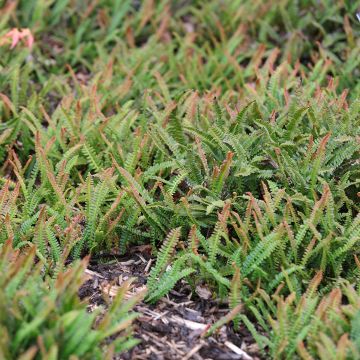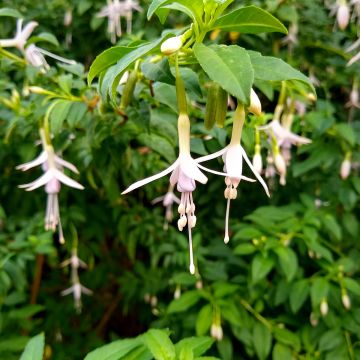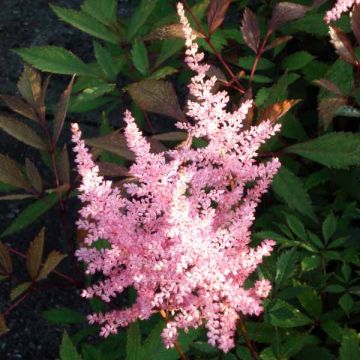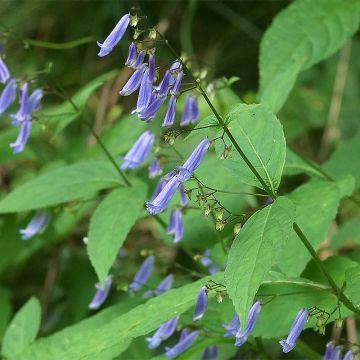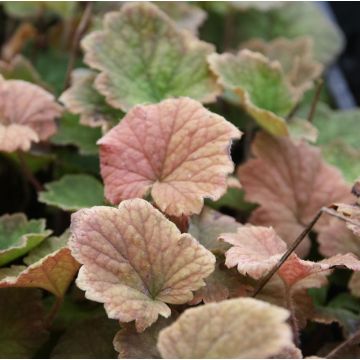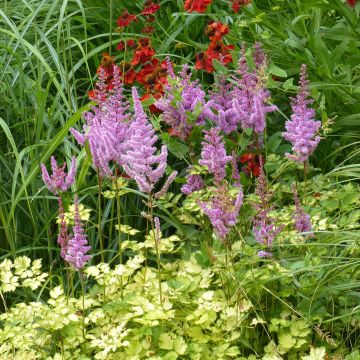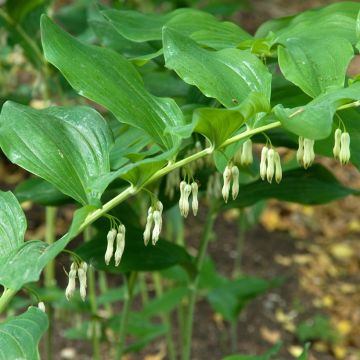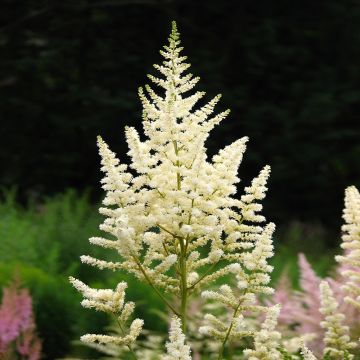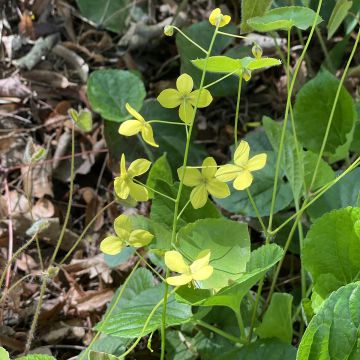

Hosta Improved White Feather
Hosta Improved White Feather
Hosta Improved White Feather
Why not try an alternative variety in stock?
View all →This plant carries a 12 months recovery warranty
More information
We guarantee the quality of our plants for a full growing cycle, and will replace at our expense any plant that fails to recover under normal climatic and planting conditions.
From €5.90 for pickup delivery and €6.90 for home delivery
Express home delivery from €8.90.
Does this plant fit my garden?
Set up your Plantfit profile →
Description
Hosta 'Improved White Feather' is an improved version of the famous 'White Feather', appreciated for its white colour but not always easy to grow. This new cultivar is more robust, with a more upright habit and thicker leaves. The plant is taller, with leaves that stand upright towards the sky. They open in white, then develop green veins, and finally bloom in a mix of cream and green. This variety is also slightly more tolerant to the sun, but it thrives in shade.
Hostas belong to the Liliaceae family. Native to Japan and China, there are more than forty species and countless horticultural varieties appreciated for their foliage. Hosta is a perennial herbaceous plant that grows easily in ordinary soil, preferably in shade. Its vegetation emerges from the ground in spring and disappears in winter.
This Hosta 'Improved White Feather' is a creation by hybridizer Arie Blom, who spent five years developing it. The plant bears lanceolate leaves in the shape of an ace of spades, with a waxy texture. In this cultivar, the leaves remain upright. The plant reaches a height of about 60 cm and a width of 40 cm. The leaves that emerge in spring are cream white, with discreet veins that are barely green. Over days and weeks, the veins turn green and green streaks invade the leaf: in summer, the foliage is strongly variegated with green. Flowering usually occurs in July-August. From the clump of leaves 50cm stems emerge bearing pale mauve flowers loved by bees. This more robust variety aims to correct the flaws of 'White Feather', whose leaves are almost chlorophyll-free in spring and show slow growth and a certain fragility.
Hosta 'Improved White Feather' is stunning in borders, but also in pots. Place it in shade so that the white foliage does not burn in spring and its white colour is magnified bright. Combine it with other varieties of hostas with green or variegated foliage, as well as with tiarellas and brunneras at the base of a large tree to create a splendid foliage display. It pairs well with many perennials such as astilbes, Japanese ferns, epimediums, and purple cimicifugas, forming beautiful combinations that require little maintenance. Its foliage conceals the gaps left by spring-flowering bulbs. It also looks great alongside lungworts and small violets... All hostas grow well in pots and can remain in the same container for several years. Choose special potting soil. As long as the foliage is not too dense, you can water from the top of the pot. Then place a saucer under the pot and pour water into it, maintaining a constant level in summer.
Report an error about the product description
Flowering
Foliage
Plant habit
Botanical data
Hosta
Improved White Feather
Asparagaceae
Cultivar or hybrid
Other Hostas - Plantain Lilies
Planting and care
Hostas are beat planted in spring or autumn. Hostas prefer a deep, rich, humus-bearing, loose soil, preferably neutral to acidic (at least low in limestone), and moist to wet throughout the year. Plant 'Improved White Feather' in partial shade or dappled shade, and a sheltered location away from strong winds.
Prepare a planting hole of 20 cm x 20 cm x 20 cm. If your soil is heavy, mix equal parts of compost with crumbled soil, partially backfill the hole, and place your potted plant so that the top of the root ball is covered with 3 cm of soil. The addition of a slow-release fertiliser (dehydrated blood, horn powder) will nourish your plant during its rooting period without the risk of burning. Make sure to position the collar well above ground level. Firm the soil and water thoroughly to eliminate air pockets. If the weather is dry, regular watering will be necessary for a few weeks to facilitate the establishment of your plant. Also, water regularly in case of a dry summer.
With their common preference for moist locations, slugs and snails are never far from hostas. Even though blue or variegated hostas often have thicker and tougher foliage, which is less appetizing to slugs, these plants still need protection. Protect your Hostas by surrounding them with ferramol-based pellets (approved for organic farming), eggshells, coffee grounds, wood chips, or any dry and rough natural substance that repels them. Hedgehogs are the gardener's best allies in the fight against slugs and snails, as unlike chickens, they do not dig up the soil or attack the tender green shoots of young plants. Finally, some plants have a repulsive odour to slugs, such as wormwood and garlic.
Planting period
Intended location
Care
This item has not been reviewed yet - be the first to leave a review about it.
Shade-loving perennials
Haven't found what you were looking for?
Hardiness is the lowest winter temperature a plant can endure without suffering serious damage or even dying. However, hardiness is affected by location (a sheltered area, such as a patio), protection (winter cover) and soil type (hardiness is improved by well-drained soil).

Photo Sharing Terms & Conditions
In order to encourage gardeners to interact and share their experiences, Promesse de fleurs offers various media enabling content to be uploaded onto its Site - in particular via the ‘Photo sharing’ module.
The User agrees to refrain from:
- Posting any content that is illegal, prejudicial, insulting, racist, inciteful to hatred, revisionist, contrary to public decency, that infringes on privacy or on the privacy rights of third parties, in particular the publicity rights of persons and goods, intellectual property rights, or the right to privacy.
- Submitting content on behalf of a third party;
- Impersonate the identity of a third party and/or publish any personal information about a third party;
In general, the User undertakes to refrain from any unethical behaviour.
All Content (in particular text, comments, files, images, photos, videos, creative works, etc.), which may be subject to property or intellectual property rights, image or other private rights, shall remain the property of the User, subject to the limited rights granted by the terms of the licence granted by Promesse de fleurs as stated below. Users are at liberty to publish or not to publish such Content on the Site, notably via the ‘Photo Sharing’ facility, and accept that this Content shall be made public and freely accessible, notably on the Internet.
Users further acknowledge, undertake to have ,and guarantee that they hold all necessary rights and permissions to publish such material on the Site, in particular with regard to the legislation in force pertaining to any privacy, property, intellectual property, image, or contractual rights, or rights of any other nature. By publishing such Content on the Site, Users acknowledge accepting full liability as publishers of the Content within the meaning of the law, and grant Promesse de fleurs, free of charge, an inclusive, worldwide licence for the said Content for the entire duration of its publication, including all reproduction, representation, up/downloading, displaying, performing, transmission, and storage rights.
Users also grant permission for their name to be linked to the Content and accept that this link may not always be made available.
By engaging in posting material, Users consent to their Content becoming automatically accessible on the Internet, in particular on other sites and/or blogs and/or web pages of the Promesse de fleurs site, including in particular social pages and the Promesse de fleurs catalogue.
Users may secure the removal of entrusted content free of charge by issuing a simple request via our contact form.
The flowering period indicated on our website applies to countries and regions located in USDA zone 8 (France, the United Kingdom, Ireland, the Netherlands, etc.)
It will vary according to where you live:
- In zones 9 to 10 (Italy, Spain, Greece, etc.), flowering will occur about 2 to 4 weeks earlier.
- In zones 6 to 7 (Germany, Poland, Slovenia, and lower mountainous regions), flowering will be delayed by 2 to 3 weeks.
- In zone 5 (Central Europe, Scandinavia), blooming will be delayed by 3 to 5 weeks.
In temperate climates, pruning of spring-flowering shrubs (forsythia, spireas, etc.) should be done just after flowering.
Pruning of summer-flowering shrubs (Indian Lilac, Perovskia, etc.) can be done in winter or spring.
In cold regions as well as with frost-sensitive plants, avoid pruning too early when severe frosts may still occur.
The planting period indicated on our website applies to countries and regions located in USDA zone 8 (France, United Kingdom, Ireland, Netherlands).
It will vary according to where you live:
- In Mediterranean zones (Marseille, Madrid, Milan, etc.), autumn and winter are the best planting periods.
- In continental zones (Strasbourg, Munich, Vienna, etc.), delay planting by 2 to 3 weeks in spring and bring it forward by 2 to 4 weeks in autumn.
- In mountainous regions (the Alps, Pyrenees, Carpathians, etc.), it is best to plant in late spring (May-June) or late summer (August-September).
The harvesting period indicated on our website applies to countries and regions in USDA zone 8 (France, England, Ireland, the Netherlands).
In colder areas (Scandinavia, Poland, Austria...) fruit and vegetable harvests are likely to be delayed by 3-4 weeks.
In warmer areas (Italy, Spain, Greece, etc.), harvesting will probably take place earlier, depending on weather conditions.
The sowing periods indicated on our website apply to countries and regions within USDA Zone 8 (France, UK, Ireland, Netherlands).
In colder areas (Scandinavia, Poland, Austria...), delay any outdoor sowing by 3-4 weeks, or sow under glass.
In warmer climes (Italy, Spain, Greece, etc.), bring outdoor sowing forward by a few weeks.

































